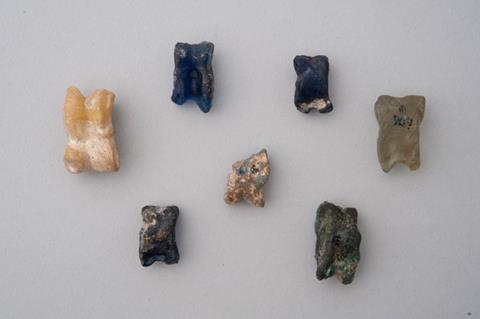These are my notes for the K5M Book Club on the book Money, by Jacob Goldstein.
Chapter 4: How to Get Rich with Probability
Oh, we’re going to get into math!!?? I’m ready, I’ve been taking this math class on probability!
You knew I was going to look up knucklebones, right?
Although knucklebone pieces were originally made from the knucklebones of sheep or goats, they were later crafted in a great variety of materials: brass, copper, silver, gold, glass, bone, ivory, marble, wood, stone, bronze, terracotta and precious gems.
From Knucklebones By Alexandra Good
The game of knucklebones, also known as astragaloi in Greek and tali in Latin, could be played in several different ways.
For women, the game of knucklebones served an oracular function. In antiquity, a woman who played knucklebones was seen as placing herself in the hands of fate.
Men, on the other hand, treated knucklebones like dice. Using only four knucklebones, men would throw the pieces onto the ground or a table thirty-five times. Each side represented a different numerical value, so that each knucklebone throw was calculated.
The idea of probability and the way it allowed John Law and others to better understand how the world works made me wonder what is the modern version of that? What cutting edge ideas are being explored by mathematicians that are allowing them to make better choices?
It reminds me a little of the question Peter Thiel* was famous for asking, “What important truth do very few people agree with you on?”
*i very much dislike peter thiel, but i do think he is smart

“One of the most important of the gambler-mathematicians was the weirdo genius Blaise Pascal”
From his delightful wikipedia page:
The 16-year-old Pascal produced, as a means of proof, a short treatise on what was called the “Mystic Hexagram”, “Essai pour les coniques” (“Essay on Conics”) and sent it—his first serious work of mathematics—to Père Mersenne in Paris; it is known still today as Pascal’s theorem.
And I Iove these quotes of his:
We know the truth, not only by the reason, but also by the heart.
All men’s miseries derive from not being able to sit in a quiet room alone.
The Unfinished Game: Pascal, Fermat & the 17th Century Letter that Made the World Modern presentation at Microsoft Research on YouTube
This is an hour plus video, but shorter than reading his book. 🙂
This video was linked from the previous one, and I had to include it because it’s the military industrial complex using Pascal’s Triangle!
This module briefly traces the mathematical achievements of Blaise Pascal, the inventor of probability theory, which form the foundation of modern science and statistics. Explains the popular conception that reality is predictable, rather than chaotic; that it tends to obey a bell curve. Connects this to Rasmussen’s Probabilistic Risk Assessment (PRA), the foundation of DHS’ risk assessment of critical infrastructure (CI). Uses the 1990s telecommunications industry as an example. Finally, addresses the limitations of PRA.
“His mathematical thinking inspired him to give up math, sell almost everything he owned, and move into a monastery.”
This doesn’t add up. If math was his path to salvation why would he give it up?
There is a 1972 film called Blaise Pascal and the Criterion Collection description of it is:
In this evocative, atmospheric biography, Roberto Rossellini brings to life philosopher and mathematician Blaise Pascal, who, amid religious persecution and ignorance, believed in a harmony between God and science.
“People were thinking in a new way—a way that was colder, and more mathy—and that bound life and death up with money.”
A friend of mine in Portland had an idea for a digital fraternity. Like an Elks lodge meets Friendster, but organized as a benefit society. Early benefit societies provided things like burial insurance for members, so the dues were more like an insurance policy, an as such…
Many major financial institutions existing today, particularly some insurance companies, mutual savings banks, and credit unions, trace their origins back to benefit societies, as can many modern fraternal organizations and fraternal orders which are now viewed as being primarily social; the modern legal system essentially requires all such organizations of appreciable size to incorporate as one of these forms or another to continue to exist on an ongoing basis.
This was much later than Pascal, but I like the idea that community was built around the financialization of death.
“Because millions of workers put a little money into the pot from every paycheck, millions of people who are too old t work get to take a little money out.”
Social security always makes me think about Universal Basic Income…



You must be logged in to post a comment.